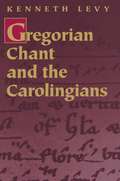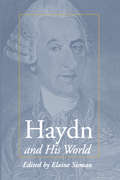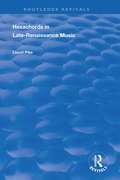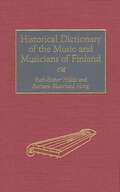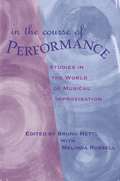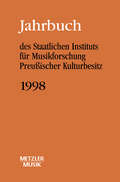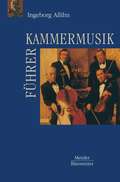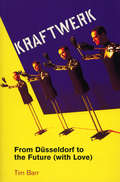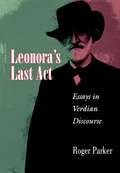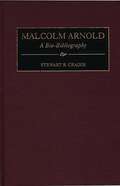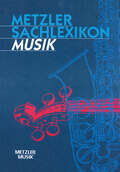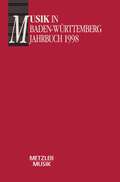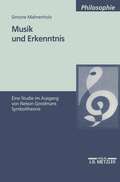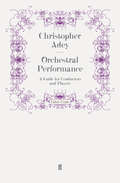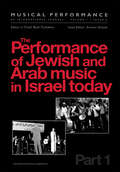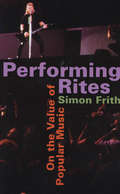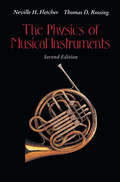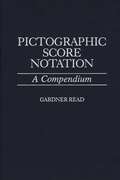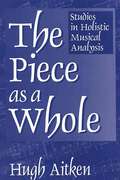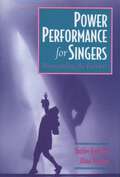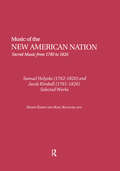- Table View
- List View
Gregorian Chant and the Carolingians
by Kenneth LevyA world-renowned scholar of plainchant, Kenneth Levy has spent a portion of his career investigating the nature and ramifications of this repertory's shift from an oral tradition to the written versions dating to the tenth century. In Gregorian Chant and the Carolingians, which represents the culmination of his research, Levy seeks to change long-held perceptions about certain crucial stages of the evolution and dissemination of the old corpus of plainchant--most notably the assumption that such a large and complex repertory could have become and remained fixed for over a century while still an oral tradition. Levy portrays the promulgation of an authoritative body of plainchant during the reign of Charlemagne by clearly differentiating between actual evidence, hypotheses, and received ideas. How many traditions of oral chant existed before the tenth century? Among the variations noted in written chant, can one point to a single version as being older or more authentic than the others? What precursors might there have been to the notational system used in all the surviving manuscripts, where the notational system seems fully formed and mature? In answering questions that have long vexed many scholars of Gregorian chant's early history, Levy offers fresh explanations of such topics as the origin of Latin neumes, the shifting relationships between memory and early notations, and the puzzling differences among the first surviving neume-species from the tenth century, which have until now impeded a critical restoration of the Carolingian musical forms.
Haydn and His World
by Elaine R. SismanJoseph Haydn's symphonies and string quartets are staples of the concert repertory, yet many aspects of this founding genius of the Viennese Classical style are only beginning to be explored. From local Kapellmeister to international icon, Haydn achieved success by developing a musical language aimed at both the connoisseurs and amateurs of the emerging musical public. In this volume, the first collection of essays in English devoted to this composer, a group of leading musicologists examines Haydn's works in relation to the aesthetic and cultural crosscurrents of his time. Haydn and His World opens with an examination of the contexts of the composer's late oratorios: James Webster connects the Creation with the sublime--the eighteenth-century term for artistic experience of overwhelming power--and Leon Botstein explores the reception of Haydn's Seasons in terms of the changing views of programmatic music in the nineteenth century. Essays on Haydn's instrumental music include Mary Hunter on London chamber music as models of private and public performance, fortepianist Tom Beghin on rhetorical aspects of the Piano Sonata in D Major, XVI:42, Mark Evan Bonds on the real meaning behind contemporary comparisons of symphonies to the Pindaric ode, and Elaine R. Sisman on Haydn's Shakespeare, Haydn as Shakespeare, and "originality." Finally, Rebecca Green draws on primary sources to place one of Haydn's Goldoni operas at the center of the Eszterháza operatic culture of the 1770s. The book also includes two extensive late-eighteenth-century discussions, translated into English for the first time, of music and musicians in Haydn's milieu, as well as a fascinating reconstruction of the contents of Haydn's library, which shows him fully conversant with the intellectual and artistic trends of the era.
Hexachords in Late-Renaissance Music (Routledge Revivals)
by Lionel PikeFirst published in 1998, this broad survey includes a large number of musical illustrations and provides an indispensable guide for both students and teachers. Hexachords and solmization syllables formed the foundations of musical language during the sixteenth century. Yet, owing to changes over time in music education and style, there no longer exists widespread general knowledge of hexachords. Without this awareness it is impossible to appreciate fully the music of the most important composers of the Renaissance such as Palestrina, Lasso and Monteverdi. This book is the first attempt to fill such a gap in our understanding of hexachords and how they were employed in late-Renaissance music. Lionel Pike’s research covers the period from Willaert to Dowland (c. 1530-1600) and examines the ways in which the uses of hexachords developed in the hands of different composers. The book concludes with an investigation of English examples of hexachords in vocal and instrumental music.
Hexachords in Late-Renaissance Music (Routledge Revivals)
by Lionel PikeFirst published in 1998, this broad survey includes a large number of musical illustrations and provides an indispensable guide for both students and teachers. Hexachords and solmization syllables formed the foundations of musical language during the sixteenth century. Yet, owing to changes over time in music education and style, there no longer exists widespread general knowledge of hexachords. Without this awareness it is impossible to appreciate fully the music of the most important composers of the Renaissance such as Palestrina, Lasso and Monteverdi. This book is the first attempt to fill such a gap in our understanding of hexachords and how they were employed in late-Renaissance music. Lionel Pike’s research covers the period from Willaert to Dowland (c. 1530-1600) and examines the ways in which the uses of hexachords developed in the hands of different composers. The book concludes with an investigation of English examples of hexachords in vocal and instrumental music.
Historical Dictionary of the Music and Musicians of Finland
by Barbara B. HongPresenting information heretofore difficult or impossible to find in English, this work opens a window on the colorful panorama of Finnish music. The 500-plus entries present historical and modern composers, the accomplishments of hundreds of internationally acclaimed performing artists, as well as more general articles on folk music, early manuscripts and publications, cantors and hymnals, early Roman Catholic, Eastern Orthodox, and Lutheran music, leading orchestras and choral groups, festivals, and much more. No other such extensive and comprehensive work on Finnish music exists in any language other than Finnish and Swedish. This English-language dictionary makes the subject available to readers throughout the world.In addition to the entries, chronologies of Finnish history and Finnish music, as well as a map of Finland, correlate history and locations with the entries. A general bibliography and entry-specific bibliographies offer further resources. The Dictionary interprets a sometimes limited amount of available information, describing forms and styles of compositions, operatic roles performed, the content of scholarly work, and significant and unusual events in the lives of the musicians.
In the Course of Performance: Studies in the World of Musical Improvisation (Chicago Studies in Ethnomusicology)
by Bruno Nettl Melinda RussellIn the Course of Performance is the first book in decades to illustrate and explain the practices and processes of musical improvisation. Improvisation, by its very nature, seems to resist interpretation or elucidation. This difficulty may account for the very few attempts scholars have made to provide a general guide to this elusive subject. With contributions by seventeen scholars and improvisers, In the Course of Performance offers a history of research on improvisation and an overview of the different approaches to the topic that can be used, ranging from cognitive study to detailed musical analysis. Such diverse genres as Italian lyrical singing, modal jazz, Indian classical music, Javanese gamelan, and African-American girls' singing games are examined. The most comprehensive guide to the understanding of musical improvisation available, In the Course of Performance will be indispensable to anyone attracted to this fascinating art. Contributors are Stephen Blum, Sau Y. Chan, Jody Cormack, Valerie Woodring Goertzen, Lawrence Gushee, Eve Harwood, Tullia Magrini, Peter Manuel, Ingrid Monson, Bruno Nettl, Jeff Pressing, Ali Jihad Racy, Ronald Riddle, Stephen Slawek, Chris Smith, R. Anderson Sutton, and T. Viswanathan.
Jahrbuch des Staatlichen Instituts für Musikforschung (SIM) Preußischer Kulturbesitz, Jahrbuch 1998
Das Jahrbuch 1998 orientiert sich an zwei inhaltlichen Schwerpunkten: Johann Sebastian Bach und die Zeit seiner Söhne einerseits und die Musik der ersten Hälfte des 20.Jahrhunderts, insbesondere der Wíener Schule, andererseits. Formkategorien in Instrumentalwerken des Fin de Siècle und der Neuen Musik behandeln die Vorträge von Werner Breig, Regina Busch, Renate Groth, Janina Klassen, Friedhelm Krummacher, Claudia Maurer Zenck, Dörte Schmidt, Martina Sichardt und Walter Werbeck, die aus Anlaß eines Symposiums zu Ehren Werner Breigs im September 1997 in Bochum gehalten wurden. Dem Umkreis der Bach-Zeit gelten die Beiträge von Werner Braun, Clemens Goldberg und Pierangelo Schiera. Mit den Anfängen des Hammerklaviers in Italien und Deutschland beschäftigen sich Christian Ahrens, Dieter Krickeberg und Konstantin Restle. Quellenkundliche Beiträge zu Graun (Christoph Henzel), Berliner Kopisten im Umfeld von Quantz (Peter Wollny) und Salieri (Ernst Dreyer) runden den Band ab.
Kammermusikführer
Das ganze Repertoire der Kammermusik. Die Autorin informiert über die wichtigsten Komponisten und Werke der Gattung seit Joseph Haydn. 160 Komponisten und ihre Werke werden ausführlich und kenntnisreich vorgestellt. Die einzelnen Artikel umfassen eine Kurzbiografie des jeweiligen Komponisten, ein Werkverzeichnis seines kammermusikalischen Schaffens, einen Essay sowie ausgewählte Besprechungen einzelner Werke, die durch Notenbeispiele illustriert sind.
Kraftwerk: from Dusseldorf to the Future With Love
by Tim BarrThe future of modern music began in Dusseldorf in 1970, when an avant-garde German band, the Organisation re-invented themselves as Kraftwerk and set in motion a train of events which introduced a whole new language into popular culture. By pre-dating electro, house, ambient and techno by more than two decades, they are quite simply the most influentual band of the late 20th century. Having studied composi-tional theory at the Dusseldorf Conservatory, they have more in common with Stockhausen and Russian Constructivism than Chuck Berry and Andy Warhol and yet, in creating classic pop hits like 'Autobahn', 'Trans Europe Express', 'The Model' and 'Tour de France' Kraftwork created a mass-market blueprint. The list of those directly and profoundly influenced is staggering: Bowie & Iggy Pop; Human League; disco (Giorgio Moroder`s seminal work with Donna Summer); Gary Numan: Sparks; Simple Minds; Orbital; Underworld; in fact, ALL modern Dance music. As well as telling the tale of this famously enigmatic and reclusive group, Tim Barr will also speak to the full range of musicians who have been touched by Kraftwerk`s extraordinary influence.
Leonora's Last Act: Essays in Verdian Discourse
by Roger ParkerIn these essays, Roger Parker brings a series of valuable insights to bear on Verdian analysis and criticism, and does so in a way that responds both to an opera-goer's love of musical drama and to a scholar's concern for recent critical trends. As he writes at one point: "opera challenges us by means of its brash impurity, its loose ends and excess of meaning, its superfluity of narrative secrets." Verdi's works, many of which underwent drastic revisions over the years and which sometimes bore marks of an unusual collaboration between composer and librettist, illustrate in particular why it can sometimes be misleading to assign fixed meanings to an opera. Parker instead explores works like Rigoletto, Il trovatore, La forza del destino, and Falstaff from a variety of angles, and addresses such contentious topics as the composer's involvement with Italian politics, the possibilities of an "authentic" staging of his work, and the advantages and pitfalls of analyzing his operas according to terms that his contemporaries might have understood. Parker takes into account many of the interdisciplinary influences currently engaging musicologists, in particular narrative and feminist theory. But he also demonstrates that close attention to the documentary evidence--especially that offered by autograph scores--can stimulate equal interpretive activity. This book serves as a model of research and critical thinking about opera, while nevertheless retaining a deep respect for opera's continuing power to touch generations of listeners.
Leonora's Last Act: Essays in Verdian Discourse (Princeton Studies in Opera #31)
by Roger ParkerIn these essays, Roger Parker brings a series of valuable insights to bear on Verdian analysis and criticism, and does so in a way that responds both to an opera-goer's love of musical drama and to a scholar's concern for recent critical trends. As he writes at one point: "opera challenges us by means of its brash impurity, its loose ends and excess of meaning, its superfluity of narrative secrets." Verdi's works, many of which underwent drastic revisions over the years and which sometimes bore marks of an unusual collaboration between composer and librettist, illustrate in particular why it can sometimes be misleading to assign fixed meanings to an opera. Parker instead explores works like Rigoletto, Il trovatore, La forza del destino, and Falstaff from a variety of angles, and addresses such contentious topics as the composer's involvement with Italian politics, the possibilities of an "authentic" staging of his work, and the advantages and pitfalls of analyzing his operas according to terms that his contemporaries might have understood. Parker takes into account many of the interdisciplinary influences currently engaging musicologists, in particular narrative and feminist theory. But he also demonstrates that close attention to the documentary evidence--especially that offered by autograph scores--can stimulate equal interpretive activity. This book serves as a model of research and critical thinking about opera, while nevertheless retaining a deep respect for opera's continuing power to touch generations of listeners.
Malcolm Arnold: A Bio-Bibliography (Bio-Bibliographies in Music)
by Stewart R. CraggsMalcolm Arnold's music encompassed a variety of forms from opera and ballet through orchestral and chamber music to film scores. His most famous film score, for which he won an Oscar award in 1957, is The Bridge on the River Kwai. In 1953 he was commissioned to compose Homage to the Queen, a ballet to celebrate the coronation of Queen Elizabeth II. Arnold was knighted by the Queen in 1993 in honor of his contributions to English music. As with the other volumes in the Greenwood Bio-Bibliographies in Music series, this work includes a brief biography, discography, complete list of works and performances, and an annotated bibliography.Music scholars, musicians, and those with an interest in the music of Malcolm Arnold will appreciate the extensive information gathered in this one volume. Since Malcolm Arnold has retired from composing, this book features the most complete list of his compositions, including some of his newly discovered early works. The works are listed alphabetically within genre. The author also provides a chronological listing of the works through which trends and developments in Arnold's compositions may be traced. Sir Malcolm Arnold's input with the project assures the accuracy and completeness of this bio-bibliography.
Metzler Sachlexikon Musik
by Ralf NoltensmeierDas kompakte Nachschlagewerk zu allen Bereichen der Musik. Das griffige Lexikon gibt Auskunft über alle Sachfragen zur Musik. Es enthält über 2.500 Artikel zu Sachen und Begriffen aus allen Bereichen der Musik - Klassik, Moderne, Weltmusik, Jazz und Unterhaltungsmusik.
Musik in Baden-Württemberg, Band 5: Jahbuch 1998
1898, vor hundert Jahren, wurde an der Universität Heidelberg mit Philipp Wolfrum der erste Professor für Musikwissenschaft im Gebiet des heutigen Bundeslandes Baden-Württemberg berufen. Aus diesem Anlaß befassen sich vier Beiträge in diesem Jahrbuch mit der Geschichte der musikwissenschaftlichen Lehre in Baden und Württemberg: Thomas Schipperges mit Heidelberg, Michael Kaufmann mit Karlsruhe, Eckhard John mit der Freiburger Ära Wilibald Gurlitts sowie Gabriela Rothmund-Gaul mit dem Amt des Tübinger Universitätsmusikdirektors. Es folgen Beiträge zu regionalgeschichtlich bedeutenden Komponisten: Hans-Bruno Ernst beschäftigt sich mit Josef Anton Laucher (1737-1813); Clytus Gottwald mit Joseph Huber (1837-1886), der zur selben Zeit wie Wagner eine eigenständige musikdramatische Form entwickelte; Lee A. Rothfarb mit August Halm (1869-1929) sowie Paul Feuchte mit dem Heidelberger Richard Franck. Neben weiteren Aufsätzen enthält der Band, wie stets, die Musikbibliographie Baden-Württemberg, die Rubrik Neue und restaurierte Orgeln" sowie einen umfangreichen Rezensionsteil zu Neuerscheinungen."
Musik und Erkenntnis: Eine Studie im Ausgang von Nelson Goodmans Symboltheorie
by Simone MahrenholzDass im Umgang mit Kunst, speziell mit Musik ein Kontakt zu so etwas wie Wahrheit oder Erkenntnis zustandekommt - Intuitionen dieser Art durchziehen nicht nur die philosophische Ästhetik seit mehreren Jahrhunderten. Sie begegnen einem beim Hören oder Erschaffen von Musik auch zuweilen selbst.
Orchestral Performance: A Guide for Conductors and Players
by Christopher AdeyA comprehensive guide to the techniques of orchestral playing and the development of non-professional orchestras, Orchestral Performance covers all areas of orchestral music-making - instrumental technique and combination, ensemble, layout, repertoire and presentation. Christopher Adey - renowned specialist in the training of student orchestras - explores the responsibilities of both players and conductor, exposing many of the inadvertent results of interpretation with regard to sound and projection, and broadening the musical communication to which the less experienced orchestra can aspire.Written in a lively and authoritative style, this unique book is essential reading for performing musicians of all standards, instrumental teachers and aspiring conductors, and all who have any dealings with the performance of youth or student orchestras throughout the world, as well as anyone interested in what orchestral performance entails. 'A labour of love and wisdom.' Times Educational Supplement'A treasure house of facts, advice, and hints. I could not put it down ... clearly written from the heart and from an obvious enthusiasm for the non-professional orchestra and orchestral musician.' Classical Music'This is a thoroughly readable book, full of illustrations and containing the thoughts of someone with a wealth of experience.' Music Teacher
The Performance of Jewish and Arab Music in Israel Today: A special issue of the journal Musical Performance
by Amnon ShiloahIsrael, with its highly heterogeneous immigrant society, offers to the observer a fascinating instance of multifaceted performance practice. Within a relatively limited area, there are numerous musical traditions and styles which encompass sacred and secular, old and new, folk and sophisticated forms. The ten contributions included in these issues of Musical Performance represent a discussion of the most significant traditions that were established during the period before 1948: the search for the establishment of a new and typically Israeli art and folk music; the attitude of the protagonists of this tendency toward the old exiled traditional heritage of the Jewish people, and the struggle of the immigrants after the creation of the State of Israel to ensure the survival of their musical tradtions as well as to cope with the new physical and cultural environment. Altogether the general scope of these contributions correspond to a large extent to major events which marked the m
The Performance of Jewish and Arab Music in Israel Today: A special issue of the journal Musical Performance
by Amnon ShiloahIsrael, with its highly heterogeneous immigrant society, offers to the observer a fascinating instance of multifaceted performance practice. Within a relatively limited area, there are numerous musical traditions and styles which encompass sacred and secular, old and new, folk and sophisticated forms. The ten contributions included in these issues of Musical Performance represent a discussion of the most significant traditions that were established during the period before 1948: the search for the establishment of a new and typically Israeli art and folk music; the attitude of the protagonists of this tendency toward the old exiled traditional heritage of the Jewish people, and the struggle of the immigrants after the creation of the State of Israel to ensure the survival of their musical tradtions as well as to cope with the new physical and cultural environment. Altogether the general scope of these contributions correspond to a large extent to major events which marked the m
Performing Rites: On the Value of Popular Music
by Simon FrithAn influential writer on popular music asks what we talk about when we talk about music. Instead of dismissing emotional response and personal taste as inaccessible to academic critics, Frith takes these forms of engagement as his subject—and discloses their place at the center of the aesthetics that structure our culture and color our lives.
The Physics of Musical Instruments
by Neville H. Fletcher Thomas D. RossingWhile the history of musical instruments is nearly as old as civilisation itself, the science of acoustics is quite recent. By understanding the physical basis of how instruments are used to make music, one hopes ultimately to be able to give physical criteria to distinguish a fine instrument from a mediocre one. At that point science may be able to come to the aid of art in improving the design and performance of musical instruments. As yet, many of the subtleties in musical sounds of which instrument makers and musicians are aware remain beyond the reach of modern acoustic measurements. This book describes the results of such acoustical investigations - fascinating intellectual and practical exercises. Addressed to readers with a reasonable grasp of physics who are not put off by a little mathematics, this book discusses most of the traditional instruments currently in use in Western music. A guide for all who have an interest in music and how it is produced, as well as serving as a comprehensive reference for those undertaking research in the field.
Pictographic Score Notation: A Compendium (Non-ser.)
by Gardner ReadThis text provides the first comprehensive examination of pictographic notation. Pictographic musical notation represents the relevant instruments themselves rendered visually rather than verbally. Used most extensively in contemporary publications between the 1950s and 1980s, its popularity has waned in recent years. This expertly researched work displays the resourcefulness and inventiveness of 20th century orchestrators.Providing a detailed examination of pictographic score notation, this unique book passes over 60 years of contemporary composition and score publications. Divided into three sections, this work describes instrumental pictographs, stage diagrams, and pictographic performance directives. In addition to the thoroughly researched information and extensive technique illustrations, commentary on individual examples and frequent cross-referencing of related examples, differentiate this work from other journal articles and notation texts.
The Piece as a Whole: Studies in Holistic Musical Analysis
by Hugh AitkenDesigned to serve music students at the college level, this informal approach to music theory relates the technical aspects of music with the expressive character of the art. The approach is holistic in the sense that it focuses on the interrelationships between the piece as heard by a socially conditioned listener and the notated, performed score: it aims to bridge the gap between the technical and expressive aspects of music. The composers addressed are: Bach, Mozart, Beethoven, Chopin, Schumann, Brahms, Wagner, Debussy, and Schoenberg. There are separate chapters on the problems of meaning in music and on the interdependence of aesthetic and ethical value-judgments. This novel and exciting approach to music theory will be a welcome addition to the musical analysis literature.
Power Performance for Singers: Transcending the Barriers
by Shirlee Emmons Alma ThomasTo perform well in today's highly competitive world where technical skills have been advanced to an unprecedented degree, a singer must be able to handle incredible pressure within the performing arena; his or her ability to deal with this stress will often determine whether he or she will succeed. Why, then, do singers with less technical skill sometimes out-perform stars? Why do some stars suddenly stop performing? What is that mysterious factor that makes an electric performance? Consistent, competent performances do not depend solely upon superior vocal skills, nor are they a matter of luck. On the contrary, the best performances result from a combination of mental attitude, concrete performing skills, and excellent technical skills in that order. Yet most singers have never had the opportunity to acquire the essential skills that make for a successful career. Written as a self-help manual for singers at all levels of expertise, Power Performance for Singers is designed to teach performing artists, and especially singers, how to experience elite performance at their level. The skills outlined in this book will help singers use what they have, to enjoy their voices during performance, and to perform consistently to the best of their present ability.
Samuel Holyoke: Selected Works (Music of the New American Nation: Sacred Music from 1780 to 1820 #12)
by Harry EskewThis series presents the music of early American composers of sacred music・psalmody, as it was called・in collected critical editions. Each volume has been prepared by a scholar who has studied the musical history of the period and the stylistic qualities of the composer. The purpose of the series is to present the music of important early American composers in accurate editions for both performance and study. This volume presents representative compositions by two American psalmodists, Samuel Holyoke and Jacob Kimball, who were actively engaged in the reform of American psalmody during the 1790s and early 1800s. American compositions were often criticized for two features: their failure to conform to the harmonic norms of European art music and their often vigorous, animated musical style, which was sometimes considered lacking in a reverent spirit appropriate for use in public worship
Samuel Holyoke: Selected Works (Music of the New American Nation: Sacred Music from 1780 to 1820)
by Harry Eskew Karl KroegerThis series presents the music of early American composers of sacred music・psalmody, as it was called・in collected critical editions. Each volume has been prepared by a scholar who has studied the musical history of the period and the stylistic qualities of the composer. The purpose of the series is to present the music of important early American composers in accurate editions for both performance and study. This volume presents representative compositions by two American psalmodists, Samuel Holyoke and Jacob Kimball, who were actively engaged in the reform of American psalmody during the 1790s and early 1800s. American compositions were often criticized for two features: their failure to conform to the harmonic norms of European art music and their often vigorous, animated musical style, which was sometimes considered lacking in a reverent spirit appropriate for use in public worship
